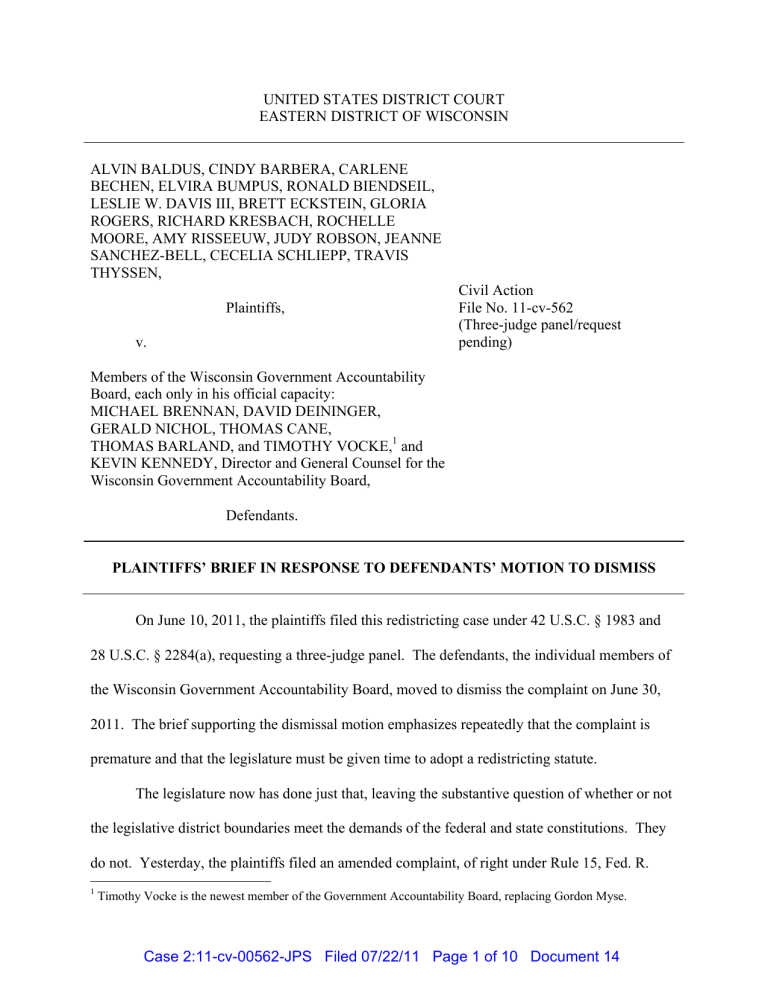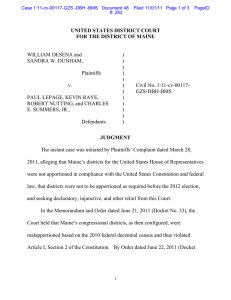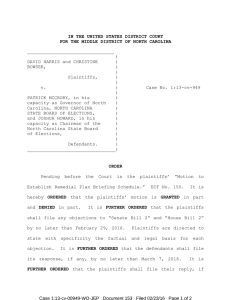UNITED STATES DISTRICT COURT EASTERN DISTRICT OF WISCONSIN

UNITED STATES DISTRICT COURT
EASTERN DISTRICT OF WISCONSIN
ALVIN BALDUS, CINDY BARBERA, CARLENE
BECHEN, ELVIRA BUMPUS, RONALD BIENDSEIL,
LESLIE W. DAVIS III, BRETT ECKSTEIN, GLORIA
ROGERS, RICHARD KRESBACH, ROCHELLE
MOORE, AMY RISSEEUW, JUDY ROBSON, JEANNE
SANCHEZ-BELL, CECELIA SCHLIEPP, TRAVIS
THYSSEN,
Plaintiffs, v.
Members of the Wisconsin Government Accountability
Board, each only in his official capacity:
MICHAEL BRENNAN, DAVID DEININGER,
GERALD NICHOL, THOMAS CANE,
THOMAS BARLAND, and TIMOTHY VOCKE,
1
and
Civil Action
File No. 11-cv-562
(Three-judge panel/request pending)
KEVIN KENNEDY, Director and General Counsel for the
Wisconsin Government Accountability Board,
Defendants.
PLAINTIFFS’ BRIEF IN RESPONSE TO DEFENDANTS’ MOTION TO DISMISS
On June 10, 2011, the plaintiffs filed this redistricting case under 42 U.S.C. § 1983 and
28 U.S.C. § 2284(a), requesting a three-judge panel. The defendants, the individual members of the Wisconsin Government Accountability Board, moved to dismiss the complaint on June 30,
2011. The brief supporting the dismissal motion emphasizes repeatedly that the complaint is premature and that the legislature must be given time to adopt a redistricting statute.
The legislature now has done just that, leaving the substantive question of whether or not the legislative district boundaries meet the demands of the federal and state constitutions. They do not. Yesterday, the plaintiffs filed an amended complaint, of right under Rule 15, Fed. R.
1
Timothy Vocke is the newest member of the Government Accountability Board, replacing Gordon Myse.
Case 2:11-cv-00562-JPS Filed 07/22/11 Page 1 of 10 Document 14
Civ. P., that raises substantive constitutional and statutory claims challenging the validity of the new legislative and Congressional district boundaries adopted by the legislature. If the complaint were ever “premature” or precautionary, it is no longer. The defendants’ motion should be denied because it has been overtaken by their own protestations: the legislature’s adoption of new district lines and the plaintiffs’ virtually immediate response challenging the legislation on its merits.
While the governor has not yet signed the legislation, the confidence in unified government conveyed by the defendants’ brief itself leaves no doubt that he will. According to one news account, moreover, the governor already has acknowledged the certainty of judicial review: “My guess [is] that no matter what maps are passed through [the legislature,] it will ultimately be decided in the courts,....” Redistricting is headed to the guv’s desk , WisPolitics PM
Update (July 21, 2011), http://www.wispolitics.com (subscription required).
Even if the legislature had not adopted new districts earlier this week, the initial complaint did not warrant dismissal. Ten years ago, this Court evaluated precisely the same issues, and it rejected the defendants’ same arguments. The defendants’ extended academic discussion in their brief on the rules and principles of civil procedure—standing, ripeness and jurisdiction—misses the point. Indeed, the defendants rely on a ritualistic citation of the dissent in the dispositive case, decided here ten years ago, but they ignore the majority’s holding.
Arrington v. Elections Bd.
, 173 F. Supp. 2d 856 (E.D. Wis. 2001) (Stadtmueller, J./three judge panel).
The Court there took and held jurisdiction, waiting for the legislature to exercise its constitutional responsibility. It never did, and the Court in 2002 had to establish legislative district lines by order. Baumgart v. Wendelberger , Nos. 01-121 and 02-366, 2002 WL 34127471
2
Case 2:11-cv-00562-JPS Filed 07/22/11 Page 2 of 10 Document 14
(E.D. Wis. May 30, 2002), amended by 2002 WL 34127473 (E.D. Wis. July 11, 2002). Now, the legislature has just adopted district lines, and the substantive question is whether they are constitutional and statutorily-valid. Then or now, with or without a legislative enactment before it, the federal court has jurisdiction because the case involves the most essential rights of citizens.
I.
ARGUMENT
THE PLAINTIFFS HAVE STANDING.
Violations of the fundamental “one person, one vote” principle create a judicially cognizable injury, and voters alleging malapportionment almost always have standing to sue in federal court. See Growe v. Emison , 507 U.S. 25, 32 (1993); Baker v. Carr , 369 U.S. 186,
207-08 (1962). Moreover, challenges to districting laws may be brought immediately upon release of the official census data showing malapportionment. Arrington , 173 F. Supp. 2d at 866. Given that holding and its supporting precedent, those challenges surely can be brought when the legislature actually has adopted new district boundaries.
A.
Voters Alleging Malapportionment Have Standing To Sue In
Federal Court.
Ten years ago, this Court asked the parties to brief the issue of standing. See Order,
Arrington v. Elections Bd.
(E.D. Wis. Feb. 28, 2001). After reviewing the parties’ briefs and considering the same arguments raised by the defendants in their now-overtaken Motion to
Dismiss, this Court concluded that the citizen-plaintiffs had standing based largely on the fact that the 2000 census data disclosed that the districts in 2001 were malapportioned. 173
F. Supp. 2d at 861-62.
Like the plaintiffs in Arrington , the plaintiffs here have alleged that the state legislative districts established by the Court in 2002 are unconstitutionally and indisputably malapportioned.
3
Case 2:11-cv-00562-JPS Filed 07/22/11 Page 3 of 10 Document 14
That harm is real, and it existed at the time the complaint was filed: population shifts during the last decade have generated substantial inequality among state assembly districts, whose populations now range from a low of 48,387 to a high of 76,116, and among senate districts with populations ranging from 152,758 to 197,821. Thus, the total population deviation from the most populous to the least populous assembly district was 27,729 people and, for the senate,
45,063 people. Complaint, ¶¶ 16(a) and (b).
The new Congressional and legislative redistricting legislation may address population equality concerns, establishing districts with small population deviations, but it does so at the expense of nearly all of the other redistricting principles established by the U.S. and Wisconsin constitutions and law. The legislation further impermissibly discriminates against the plaintiffs in the flawed and gerrymandering process used to pass the plan, and the resulting districts unconstitutionally discriminate against the plaintiffs’ opportunity to influence the political process for at least the next decade.
The injuries to the plaintiffs’ voting and representational rights are direct and immediate as well and, now that the legislature has tried to establish new districts, they could not be more concrete. The malapportionment and, with the legislation’s adoption, misapportionment of state legislative districts dilute the voting strength of the plaintiffs in violation of the “one person, one vote” principle recognized by the U.S. Supreme Court nearly 50 years ago and in violation of the complementary provisions of state and federal law described in detail in the complaint and the amended complaint.
The mal- and misapportionment significantly limit the plaintiffs’ effective participation in the political process. “[R]epresentative government is in essence self-government through the medium of elected representatives of the people, and each and every citizen has an inalienable
4
Case 2:11-cv-00562-JPS Filed 07/22/11 Page 4 of 10 Document 14
right to full and effective participation in the political processes of his State’s legislative bodies.”
Reynolds v. Sims , 377 U.S. 533, 565 (1964). Without new and constitutionally-valid district boundaries, the plaintiffs no longer have effective representation. For example, the unnecessary dislocation of thousands of voters and the disenfranchisement of almost 300,000 people in state senate districts are impermissible.
The plaintiffs’ rights are further compromised because the uncertainty surrounding the new district boundaries significantly diminishes the ability of any potential candidate to campaign effectively. Until new constitutionally-valid districts are in place, candidates cannot campaign or be encouraged to run, campaign committees cannot be formed, supporters cannot be enlisted, and contributions cannot be solicited or made.
Given the amended complaint, this response to an overtaken motion to dismiss is not the place to argue the merits of the new legislative boundaries. For now, it is enough to say, as does the amended complaint, that the legislative enactment makes massive, unnecessary and unconstitutional changes in the state’s political geography. See , e.g.
, Amended Complaint,
¶¶ 30, 31, 36, 42, 48, 51, 56, 65 and 75. The end result is a significant burden on the plaintiffs’ voting rights and election choices.
B.
One-Party Control Of The Legislature And Governor’s Office
Does Not Eliminate The Plaintiffs’ Standing.
The defendants hang their hat on the fact that the legislature and governor are now controlled by the same party and, as a result, there can be no risk of the state failing to adopt constitutionally-valid legislative districts. Far from undermining the plaintiffs’ standing, the novelty of one-party control enhances it: the Amended Complaint specifically includes a detailed claim for unconstitutional partisan gerrymandering. See Amended Complaint, ¶¶ 55 to 61.
5
Case 2:11-cv-00562-JPS Filed 07/22/11 Page 5 of 10 Document 14
This argument—and the underlying facts themselves—ignore the well-established redistricting jurisprudence that has consistently held that citizens have standing to bring redistricting lawsuits in federal court. These cases, which include this Court’s own
November 28, 2001 decision in Arrington , in no way support the contention that a federal court has jurisdiction over redistricting litigation only when there is a split legislature or when different parties control the legislature and the governor’s office. Unchecked control has now resulted in legislative boundaries that violate state and federal constitutional rights.
2
To be sure, there is never a guarantee that any state legislature will timely establish constitutionally-valid districts, even with the same party controlling both chambers of the legislature and the governor’s office. See , e.g.
, Cox v. Larios , 542 U.S. 947 (2004) (affirming the district court’s judgment that Georgia’s legislative reapportionment plan, passed by a
Democratically-controlled legislature and signed by a Democratic governor, was unconstitutional). That is, even if the legislature has drawn new districts, as it now has, this
Court has the right—indeed, the obligation—to ensure that the boundaries are constitutional.
See , e.g.
, Voinovich v. Quilter , 507 U.S. 146 (1993) (federal courts are bound to respect the states’ apportionment plans unless those plans contravene federal requirements); Sexson v.
Servaas , 33 F.3d 799, 803 (7th Cir. 1994) (if state apportionment violates federal law, the federal interest trumps any state interest).
II.
THE MATTER IS RIPE FOR JUDICIAL DETERMINATION.
The very existence of malapportioned districts renders the lawsuit ripe. A claim is ripe for review if the plaintiffs stand to suffer a “palpable” injury. Arrington , 173 F. Supp. 2d at 862
( citing Valley Forge Christian College v. Americans United for Separation of Church & State,
2
The Court can take judicial notice that in light of nine pending recall elections, control of the state senate may change.
6
Case 2:11-cv-00562-JPS Filed 07/22/11 Page 6 of 10 Document 14
Inc.
, 454 U.S. 464, 491 (1982)). Courts (including this Court) already have determined that the ripeness standard is met in redistricting cases as soon as new census numbers are made available.
Id.
at 866-67. That happened months ago. Now that the legislature has adopted a challenged plan, the plaintiffs’ claims are surely ripe.
As a matter of federal-state comity, the U.S. Supreme Court has determined that federal courts must defer drawing new district boundaries to provide time for the state to try to meet its constitutional obligation. Growe , 507 U.S. at 33. The directive that a federal court refrain from immediately redrawing the district boundaries, however, does not mean that the issue is not ripe.
The need to allot time for the state to act may limit the remedies immediately available to the federal court, but that timing does not change the immediacy of the injury. The harm is real, it existed on the day the complaint was filed, and it continues today—especially in light of the new legislation.
III.
THE PLAINTIFFS HAVE STATED A CLAIM UPON WHICH RELIEF
MAY BE GRANTED.
According to the defendants, the complaint fails to satisfy the Twombly standard because the plaintiffs’ right to relief is merely speculative. The plaintiffs’ right to relief, the state maintains, does not now exist. It is instead dependent on future conduct. Defendants’ Brief at 16-17. The “plaintiffs have jumped the gun….” Id . at 23. They are mistaken.
The U.S. Supreme Court restated the standard for notice pleading and the sufficiency of pleadings in Bell Atlantic Corp. v. Twombly , 550 U.S. 544 (2007). Under it, a complaint will not survive a motion to dismiss if it offers only conclusions or provides only a formulaic recitation of the elements of a cause of action. Ashcroft v. Iqbal , 129 S. Ct. 1937, 1949 (2009). “To survive a motion to dismiss, a complaint must contain sufficient factual matter, accepted as true, to ‘state a
7
Case 2:11-cv-00562-JPS Filed 07/22/11 Page 7 of 10 Document 14
claim to relief that is plausible on its face.’” Id.
Plausibility means that a plaintiff’s right to relief must be more than mere speculation.
Contrary to the defendants’ assertions, the plaintiffs’ right to relief was and is in no way speculative and in no way dependent or conditional. The original complaint alleges that the 2010 census data disclosed that the 2002 assembly and senate districts were malapportioned and, as a result, these districts violated the plaintiffs’ rights under the Due Process Clause and the Equal
Protection Clause, which guarantee that the vote of each citizen shall be equally effective with the vote of any and every other citizen. See Complaint, ¶¶ 8, 14-17. The plaintiffs sought and still seek from this Court relief from Wisconsin’s unconstitutional legislative districts, id.
,
¶¶ 21-27—first, in the absence of redistricting legislation and, now, in the face of legislation that establishes new boundaries but does so unconstitutionally. See generally Amended Complaint,
¶¶ 30, 31, 36, 42, 48, 51, 56, 65 and 75.
In Arrington , this Court determined that, under less compelling facts, the plaintiffs’ harm was in no way speculative or hypothetical and was, instead, ripe for adjudication. 173
F. Supp. 2d at 866-67. Simply because—as a matter of federal-state comity—the complaint recognized that this Court must defer drawing new district boundaries to provide time for the state to meet its obligation does not convert the plaintiffs’ right to relief to mere speculation. The plaintiffs’ right to relief is quite real—now, more than ever.
IV.
THIS COURT SHOULD NOT ABSTAIN.
When a redistricting lawsuit is brought in federal court that challenges the state’s failure to act, the proper procedure is for the court to set a deadline for the state to draw constitutionally-valid district boundaries, retain jurisdiction, and stay action in the federal court unless and until the state fails to meet this deadline. See id . at 867; Growe , 507 U.S. at 33, 36;
Scott v. Germano , 381 U.S. 407, 409 (1965) ( per curiam ).
8
Case 2:11-cv-00562-JPS Filed 07/22/11 Page 8 of 10 Document 14
Reapportionment jurisprudence has long recognized that a case or controversy exists immediately after the completion of the decennial census, acknowledging the primacy of the state in creating and undertaking a statutory process for apportioning legislative districts during the time period between the completion of the census and the first regularly scheduled elections.
The former principle allows the case to remain pending as a case or controversy while the complementary principle requires the court to stay its hand until the state’s process has been completed. See Growe , 507 U.S. at 33, 36; Germano , 381 U.S. at 409. Deferral ensures that the federal courts do not interfere with a state’s attempts to meet its constitutional obligations but allows a federal court to retain jurisdiction. Without retaining jurisdiction, any deadline for state action would be—would have been—merely advisory. Accordingly, deferral—and not abstention—would have been the appropriate course of action.
In the case that a state fails to timely draw constitutionally-valid districts, it is incumbent upon the court to undertake the process of reapportionment. Indeed, although states have the primary responsibility for redistricting, states often encounter difficulties in redistricting, and federal court review of the states’ redistricting is quite common. Wisconsin is no exception: the state’s redistricting efforts have ended in federal court following the 1980, 1990 and 2000 census.
3
The plaintiffs recognize that the legislation adopted by the state legislature does not stop at creating new senate, assembly, and Congressional boundaries. It provides for special state judicial procedures for adjudicating challenges to those boundaries. The legislation directs the state supreme court to establish a special court, composed of designated appellate judges, and
3
On July 20, 2011, the leadership of the Illinois Republican Party filed a redistricting lawsuit making many of the same allegations found in the plaintiffs’ Amended Complaint here. Radogno et al. v. Illinois State Bd. of Elections et al.
, No. 11-4884 (N.D. Ill.). They filed it not in state court but in the federal district court for the Northern
District of Illinois.
9
Case 2:11-cv-00562-JPS Filed 07/22/11 Page 9 of 10 Document 14
provides for direct and immediate appeal to the state supreme court. See SB 150, as amended.
Nonetheless, whether or not the legislature has the authority to dictate jurisdiction and procedure to the state judiciary—a separation of powers question for the state judiciary—it does not have that authority or any authority with respect to federal courts.
At this time, however, neither deferral nor abstention is necessary. In fact, there is no state litigation to which to defer, no state proceeding of any kind that justifies abstention.
CONCLUSION
The complaint in this action comports with the procedures outlined in Growe and
Germano . This Court has a duty to prevent the denial of constitutionally-protected rights of
Wisconsin’s electors. Ten years ago, the federal district court faced this situation, ruling that it had jurisdiction—even before it had a legislative districting plan before it. Now that it has that plan, the motion to dismiss should be denied.
Dated: July 22, 2011.
GODFREY & KAHN, S.C.
By:
Rebecca Kathryn Mason
State Bar No. 1055500
One East Main Street, Suite 500
P.O. Box 2719
Madison, WI 53701-2719
608-257-3911 rmason@gklaw.com
Attorneys for Plaintiffs
6555098_4
10
Case 2:11-cv-00562-JPS Filed 07/22/11 Page 10 of 10 Document 14




